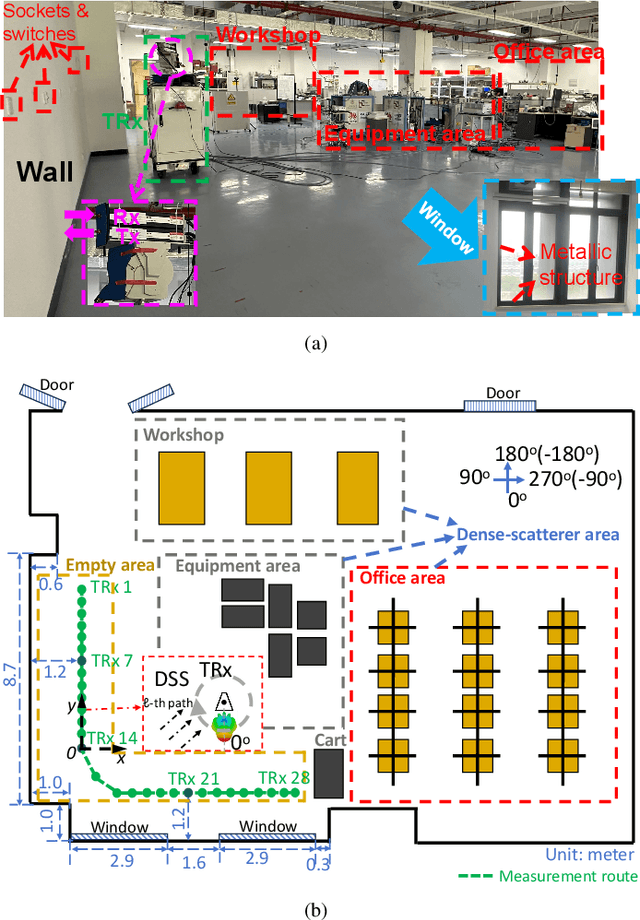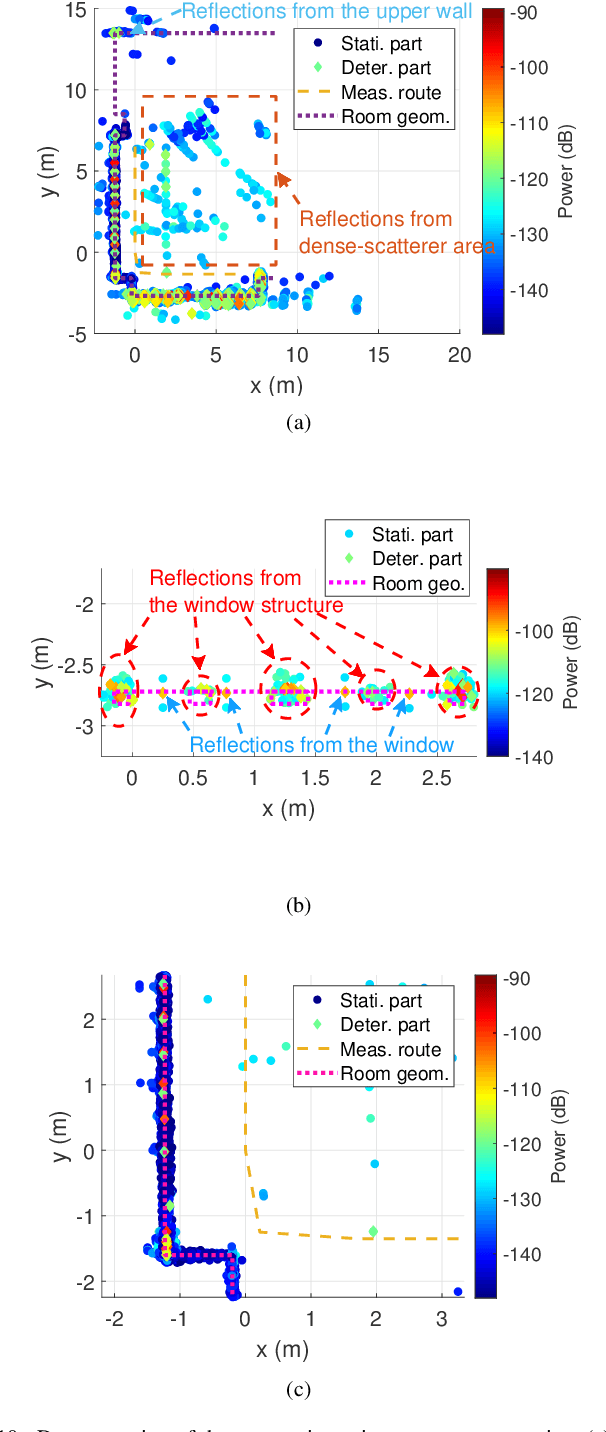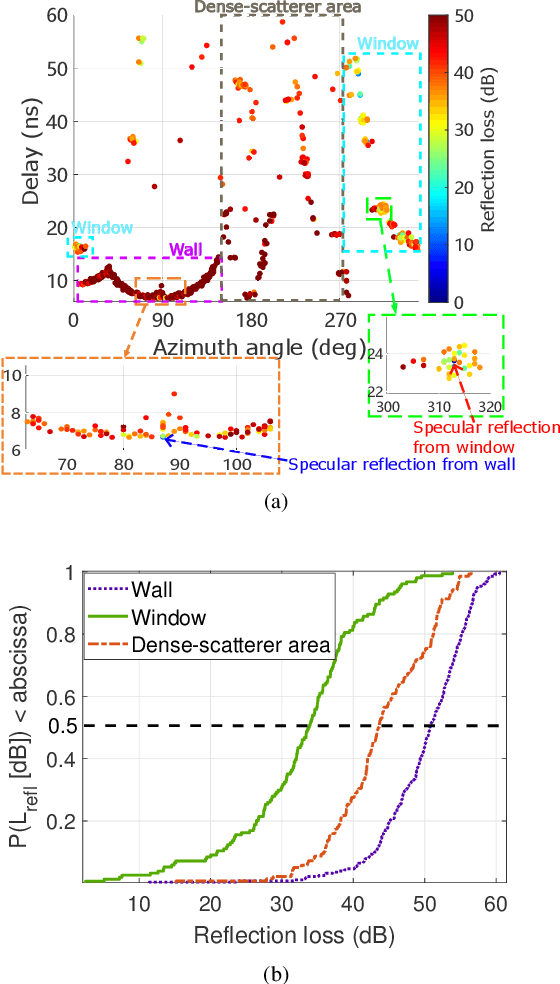Chong Han
Hybrid Beamforming with Orthogonal delay-Doppler Division Multiplexing Modulation for Terahertz Sensing and Communication
Feb 25, 2025Abstract:The Terahertz band holds a promise to enable both super-accurate sensing and ultra-fast communication. However, challenges arise that severe Doppler effects call for a waveform with high Doppler robustness while severe propagation path loss urges for an ultra-massive multiple-input multiple-output (UM-MIMO) structure. To tackle these challenges, hybrid beamforming with orthogonal delay-Doppler multiplexing modulation (ODDM) is investigated in this paper. First, the integration of delay-Doppler waveform and MIMO is explored by deriving a hybrid beamforming-based UM-MIMO ODDM input-output relation. Then, a multi-dimension sensing algorithm on target azimuth angle, elevation angle, range and velocity is proposed, which features low complexity and high accuracy. Finally, a sensing-centric hybrid beamforming is proposed to design the sensing combiner by minimizing the Cram\'er-Rao lower bounds (CRLB) of angles. After that, the precoder that affects both communication and sensing is then designed to maximize the spectral efficiency. Numerical results show that the sensing accuracy of the proposed sensing algorithm is sufficiently close to CRLB. Moreover, the proposed hybrid beamforming design allows to achieve maximal spectral efficiency, millimeter-level range estimation accuracy, millidegree-level angle estimation accuracy and millimeter-per-second-level velocity estimation accuracy. Take-away lessons are two-fold. Combiner design is critical especially for sensing, which is commonly neglected in hybrid beamforming design for communication. Furthermore, the optimization problems for communication and sensing can be decoupled and solved independently, significantly reducing the computational complexity of the THz monostatic ISAC system.
Terahertz Aerospace Communications: Enabling Technologies and Future Directions
Feb 25, 2025Abstract:To achieve ubiquitous connectivity in next-generation networks through aerospace communications while maintaining high data rates, Terahertz (THz) band communications (0.1-10 THz) with large continuous bandwidths are considered a promising candidate technology. However, key enabling techniques and practical implementations of THz communications for aerospace applications remain limited. In this paper, the wireless channel characteristics, enabling communication techniques, and networking strategies for THz aerospace communications are investigated, aiming to assess their feasibility and encourage future research efforts toward system realization. Specifically, the wireless channel characteristics across various altitudes and scenarios are first analyzed, focusing on modeling the interaction between the THz wave and the external environment, from ground to outer space. Next, key enabling communication technologies, including multiple-input multiple-output (MIMO) technique, beam alignment and tracking, integrated communication and radar sensing (ICARS), and resource allocation for networking are discussed. Finally, the existing challenges and possible future directions are summarized and discussed.
Joint Communication and Radar Sensing for Terahertz Space-Air-Ground Integrated Networks (SAGIN)
Feb 25, 2025Abstract:The transition from isolated systems to integrated solutions has driven the development of space-air-ground integrated networks (SAGIN) as well as the integration of communication and radar sensing functionalities. By leveraging the unique properties of the Terahertz (THz) band, THz joint communication and radar sensing (JCRS) supports high-speed communication and precise sensing, addressing the growing demands of SAGIN for connectivity and environmental awareness. However, most existing THz studies focus on terrestrial and static scenarios, with limited consideration for the dynamic and non-terrestrial environments of SAGIN. In this paper, the THz JCRS techniques for SAGIN are comprehensively investigated. Specifically, propagation characteristics and channel models of THz waves in non-terrestrial environments are analyzed. A link capacity comparison with millimeter-wave, THz, and free-space optical frequency bands is conducted to highlight the advantages of THz frequencies. Moreover, novel JCRS waveform design strategies are presented to achieve mutual merit of communication and radar sensing, while networking strategies are developed to overcome challenges in SAGIN such as high mobility. Furthermore, advancements in THz device technologies, including antennas and amplifiers, are reviewed to assess their roles in enabling practical JCRS implementations.
DNN based Two-stage Compensation Algorithm for THz Hybrid Beamforming with imperfect Hardware
Nov 22, 2024Abstract:Terahertz (THz) communication is envisioned as a key technology for 6G and beyond wireless systems owing to its multi-GHz bandwidth. To maintain the same aperture area and the same link budget as the lower frequencies, ultra-massive multi-input and multi-output (UM-MIMO) with hybrid beamforming is promising. Nevertheless, the hardware imperfections particularly at THz frequencies, can degrade spectral efficiency and lead to a high symbol error rate (SER), which is often overlooked yet imperative to address in practical THz communication systems. In this paper, the hybrid beamforming is investigated for THz UM-MIMO systems accounting for comprehensive hardware imperfections, including DAC and ADC quantization errors, in-phase and quadrature imbalance (IQ imbalance), phase noise, amplitude and phase error of imperfect phase shifters and power amplifier (PA) nonlinearity. Then, a two-stage hardware imperfection compensation algorithm is proposed. A deep neural network (DNN) is developed in the first stage to represent the combined hardware imperfections, while in the second stage, the digital precoder in the transmitter (Tx) or the combiner in the receiver (Rx) is designed using NN to effectively compensate for these imperfections. Furthermore, to balance the performance and network complexity, three slimming methods including pruning, parameter sharing, and removing parts of the network are proposed and combined to slim the DNN in the first stage. Numerical results show that the Tx compensation can perform better than the Rx compensation. Additionally, using the combined slimming methods can reduce parameters by 97.2% and running time by 39.2% while maintaining nearly the same performance in both uncoded and coded systems.
Modeling and Analysis of Terahertz Wave Propagation in Charged Dust Using Extended Mie Scattering Theory
Nov 19, 2024Abstract:Terahertz (THz) band (0.1-10 THz) possesses multi-gigahertz continuous bandwidth resources, making it a promising frequency band for high-speed wireless communications and environment sensing. The interaction between the THz wave and the external environment has been studied for various scenarios. However, it has recently been revealed that the friction forces in dust storms as well as the irradiation of sunlight and solar wind lead to the electrification of dust particles on Earth and the Moon. The THz wave propagation in these charged dust has not been fully investigated, which is essential for THz aerial communications in dust storms and lunar communications. In this paper, a channel model for THz wave propagation in charged dust is developed for wireless communications. Specifically, an extended Mie scattering model for charged dust is first introduced, which captures the electrodynamic feature of the interaction between THz wave and charged particles. Then, the diameter and density distributions of dust particles are modeled, based on which the propagation loss of THz wave in charged dust is modeled and elaborated. Finally, numerical results on the additional loss caused by these charged dust with different sizes in the THz band are evaluated and compared. Extensive results demonstrate that as the number of dust charges increases, the extinction cross section of smaller-sized particles significantly increases, and the overall attenuation led by charged dust increases by at most 50% at 0.3 THz.
Dual-Functional FMCW Waveform for Terahertz Space Debris Detection and Inter-Satellite Communications
Nov 19, 2024Abstract:Terahertz (THz) band communication, ranging from 0.1 THz to 10 THz, is envisioned as a key enabling technology for next-generation networks and future applications such as inter-satellite communications and environmental sensing. The surging number of space debris in Low Earth Orbit poses a big threat to orbital infrastructure and the development of the space economy. In particular, despite the ability to detect and track large-scale space debris, millions of space debris with a radius within the range of 0.1-10 cm and velocity exceeding 1 km/s remains hard to detect with conventional ground-based radars and optical telescopes. In this study, a dual-functional frequency modulated continuous waveform (FMCW) operating in the THz band is adopted for space debris sensing and inter-satellite communications. Specifically, the radar cross section of space debris with various sizes in the THz band is analyzed to demonstrate the feasibility of THz space debris detection. A joint space debris detection and inter-satellite communications based on the FMCW waveform is derived. Then, the parameter estimation and demodulation algorithms are illustrated. Extensive simulations demonstrate that the proposed method can realize high-accuracy parameter estimation of hypervelocity space debris while achieving high reliability for inter-satellite communications.
Hybrid Channel Modeling and Environment Reconstruction for Terahertz Monostatic Sensing
Nov 12, 2024



Abstract:THz ISAC aims to integrate novel functionalities, such as positioning and environmental sensing, into communication systems. Accurate channel modeling is crucial for the design and performance evaluation of future ISAC systems. In this paper, a THz measurement campaign for monostatic sensing is presented. VNA-based channel measurements are conducted in a laboratory scenario, where the transmitter and receiver are positioned together to mimic monostatic sensing. The centering frequency and measured bandwidth for these measurements are 300 GHz and 20 GHz, respectively. A DSS scheme is employed to capture spatial sensing channel profiles. Measurements are conducted across 28 transceiver locations arranged along an 'L'-shaped route. Then, an element-wise SAGE algorithm is used to estimate the MPC parameters, i.e., amplitude and delay. Specular and diffuse reflections are analyzed based on geometric principles and the estimated MPC parameters, where the effects from the radiation pattern are observed. A geometry-based MPC trajectory tracking algorithm is then proposed to classify the MPCs and de-embed the effects of the radiation pattern. Following this algorithm, a hybrid channel model is proposed based on the de-embedded MPC parameters. In this hybrid channel model for monostatic sensing, the MPCs are categorized into target-related and environment-related components. The target-related components are utilized for target detection and identification, while the environment-related ones focus on geometrical scenario reconstruction. A demonstration of geometrical environment reconstruction, along with an analysis of reflection loss for target identification, is subsequently presented. This work offers valuable insights into THz monostatic sensing channel modeling and the design of future THz ISAC systems.
Centimeter-level Geometry Reconstruction and Material Identification in 300 GHz Monostatic Sensing
Oct 30, 2024Abstract:Terahertz (THz) integrated sensing and communication (ISAC) technology is envisioned to achieve high communication performance alongside advanced sensing abilities. For various applications of ISAC, accurate environment reconstruction including geometry reconstruction and material identification is critical. This paper presents a highly precise geometry reconstruction algorithm and material identification scheme for a monostatic sensing case in a typical indoor scenario. Experiments are conducted in the frequency range from 290 GHz to 310 GHz using a vector network analyzer (VNA)-based channel sounder by co-locating the transmitter and receiver. A joint delay and angle space-alternating generalized expectation-maximization (SAGE)-based algorithm is implemented to estimate multipath component (MPC) parameters and the indoor geometry is reconstructed based on the extracted parameters. Furthermore, a geometry-based method is employed to model and remove the spurious path of the corner, reaching an accuracy of 1.75 cm. Additionally, a material database using THz time-domain spectroscopy (THz-TDS) is established, capturing reflection losses of over 200 common material samples. Applying this database to our monostatic sensing, the measured reflection losses of wall and window frame are accurately identified as cement and steel, respectively. Our results demonstrate the centimeter-level geometry reconstruction and accurate material identification for practical THz ISAC scenarios, which unleash unprecedented sensing potential compared to microwave and millimeter-wave bands.
Tera-SpaceCom: GNN-based Deep Reinforcement Learning for Joint Resource Allocation and Task Offloading in TeraHertz Band Space Networks
Sep 12, 2024



Abstract:Terahertz (THz) space communications (Tera-SpaceCom) is envisioned as a promising technology to enable various space science and communication applications. Mainly, the realm of Tera-SpaceCom consists of THz sensing for space exploration, data centers in space providing cloud services for space exploration tasks, and a low earth orbit (LEO) mega-constellation relaying these tasks to ground stations (GSs) or data centers via THz links. Moreover, to reduce the computational burden on data centers as well as resource consumption and latency in the relaying process, the LEO mega-constellation provides satellite edge computing (SEC) services to directly compute space exploration tasks without relaying these tasks to data centers. The LEO satellites that receive space exploration tasks offload (i.e., distribute) partial tasks to their neighboring LEO satellites, to further reduce their computational burden. However, efficient joint communication resource allocation and computing task offloading for the Tera-SpaceCom SEC network is an NP-hard mixed-integer nonlinear programming problem (MINLP), due to the discrete nature of space exploration tasks and sub-arrays as well as the continuous nature of transmit power. To tackle this challenge, a graph neural network (GNN)-deep reinforcement learning (DRL)-based joint resource allocation and task offloading (GRANT) algorithm is proposed with the target of long-term resource efficiency (RE). Particularly, GNNs learn relationships among different satellites from their connectivity information. Furthermore, multi-agent and multi-task mechanisms cooperatively train task offloading and resource allocation. Compared with benchmark solutions, GRANT not only achieves the highest RE with relatively low latency, but realizes the fewest trainable parameters and the shortest running time.
Movable Antennas: Channel Measurement, Modeling, and Performance Evaluation
Sep 05, 2024Abstract:Since decades ago, multi-antenna has become a key enabling technology in the evolution of wireless communication systems. In contrast to conventional multi-antenna systems that contain antennas at fixed positions, position-flexible antenna systems have been proposed to fully utilize the spatial variation of wireless channels. In this paper, movable antenna (MA) systems are analyzed from channel measurement, modeling, position optimization to performance evaluation. First, a broadband channel measurement system with physical MAs is developed, for which the extremely high movable resolution reaches 0.02 mm. A practical two-ray model is constructed based on the channel measurement for a two-dimensional movable antenna system across 32$\times$32 planar port positions at 300 GHz. In light of the measurement results, spatial-correlated channel models for the two-dimensional MA system are proposed, which are statistically parameterized by the covariance matrix of measured channels. Finally, the signal-to-interference-and-noise ratio (SINR)-maximized position selection algorithm is proposed, which achieves 99% of the optimal performance. The performance of different MA systems in terms of spectral efficiency are evaluated and compared for both planar and linear MA systems. Extensive results demonstrate the advantage of MAs over fixed-position antennas in coping with the multi-path fading and improving the spectral efficiency by 10% in a 300 GHz measured channel.
 Add to Chrome
Add to Chrome Add to Firefox
Add to Firefox Add to Edge
Add to Edge